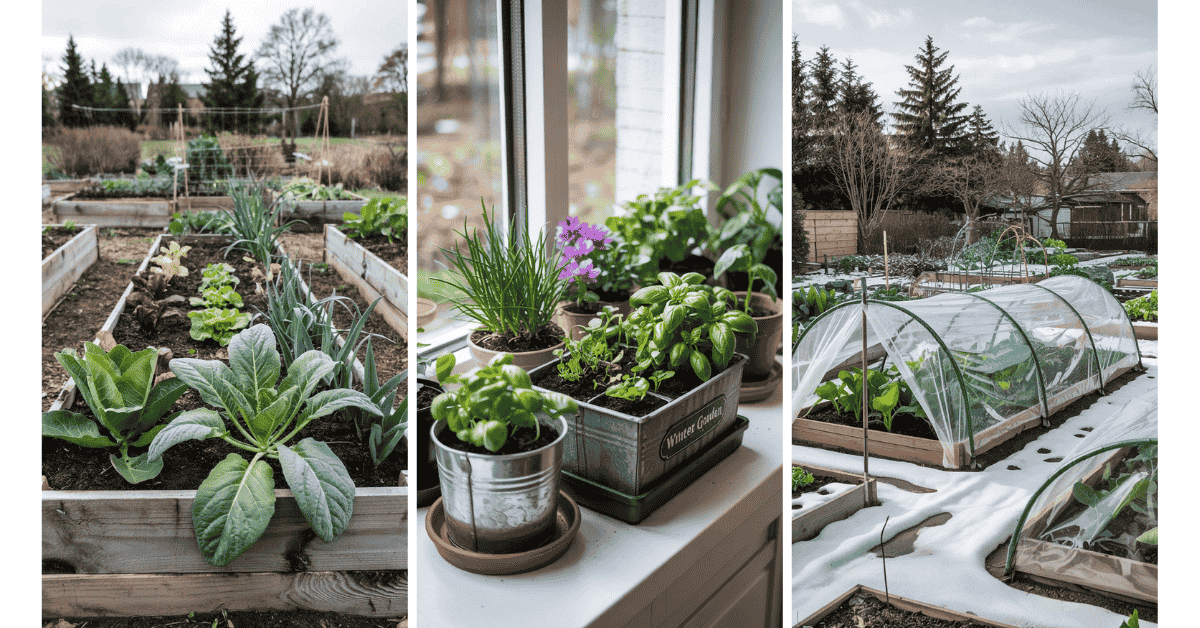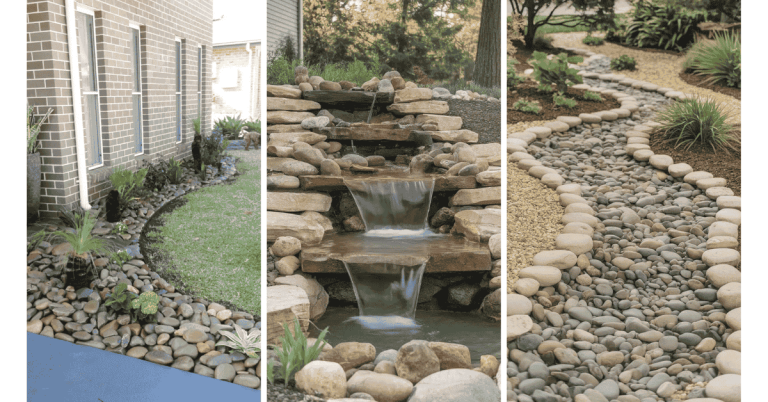
Winter doesn’t have to mean the end of your garden’s beauty. While many gardeners retreat indoors when temperatures drop, the cold season offers unique opportunities to create stunning landscapes filled with texture, color, and life.
From dramatic bark displays to cheerful winter blooms, these 20 winter garden ideas will help you maintain an enchanting outdoor space that thrives even in the harshest conditions.
20 Winter Garden Ideas
1. Start Seeds Indoors for Cold-Season Vegetables

Get a head start on your winter harvest by beginning seeds indoors during late summer or early fall. This crucial step helps establish robust plants before the outdoor temperatures drop significantly.
Cold-hardy vegetables like broccoli, cauliflower, kale, cabbage, and peas typically need 65-90 days to mature, making indoor seed starting essential for winter gardening success.
Calculate your planting schedule by subtracting about 100 days from your area’s average first frost date to ensure optimal timing.
This approach ensures your plants are strong and developed enough to handle outdoor conditions when transplanted, giving you a continuous supply of fresh vegetables throughout the colder months.
2. Install Protective Garden Covers

Extend your growing season significantly with protective structures like poly tunnels, cold frames, and frost cloth.
These coverings are invaluable as they trap solar heat and effectively shield delicate plants from harsh winds, heavy snow, and freezing rain, creating beneficial microclimates that can be 10-15 degrees warmer than the surrounding air.
Support your covers with sturdy hoops or poles to prevent collapse under snow load, and keep readily available bed sheets or blankets on hand as emergency alternatives during unexpected and severe cold snaps.
These simple additions can make all the difference in keeping your winter crops thriving.
3. Choose Frost-Hardy Plant Varieties

Selecting the right plants is the cornerstone of effortless winter gardening. Cold-hardy vegetables like kale, Swiss chard, spinach, and cabbage can not only withstand temperatures well below freezing but often develop a sweeter, more tender flavor after exposure to frost.
For future harvests, plant garlic bulbs in the fall; they will overwinter and be ready for harvest the following summer.
Additionally, ensure raised beds are thoroughly watered before an anticipated freeze to help protect root systems from desiccation and severe damage, as moist soil retains heat better than dry soil.
4. Grow Sprouts and Microgreens Indoors

Transform any indoor space into a productive and nutritious growing area with sprouts and microgreens.
These nutrient-dense foods require minimal space and equipment, making them perfect for urban dwellers or those with limited outdoor gardening options.
Simply grow sprouts in specialized sprouting jars or even simple mason jars and cultivate microgreens under artificial lights or in a sunny window for a continuous harvest.
Popular varieties include vibrant pea shoots, peppery radish microgreens, and crunchy mung bean sprouts, all of which provide fresh flavors and vital nutrients during winter months when fresh produce can be scarce and expensive.
5. Create a Windowsill Container Garden

Maximize limited indoor space with a sunny windowsill garden, ideally facing south for optimal light exposure throughout the day.
Container gardens are perfectly suited for growing a variety of herbs like fragrant basil, versatile parsley, and zesty chives, as well as tender leafy greens such as lettuce and spinach.
Use well-draining pots with saucers to protect your surfaces from excess moisture, and remember to rotate plants regularly to ensure even growth and exposure to light, preventing them from becoming leggy.
6. Plant Winter-Blooming Flowers

Add a much-needed splash of vibrant color to dreary winter landscapes with cold-tolerant flowering plants.
Pansies, dianthus, resilient black-eyed Susans, and cheerful coneflowers provide beautiful blooms that can bravely withstand light frosts and even brief snow cover.
Many winter flowers actually perform better in cooler temperatures, offering longer-lasting and more intense displays than their summer counterparts, providing a welcome respite from winter’s monochromatic palette.
7. Showcase Trees with Attractive Winter Bark

Winter truly reveals the hidden beauty and sculptural qualities of tree bark, making it a stunning focal point in dormant gardens. The elegant Paperbark Maple (Acer griseum) displays distinctive cinnamon-colored bark that peels in delicate, papery sheets, creating year-round interest.
Meanwhile, Coral Bark Maples boast brilliant, eye-catching red stems that glow in the winter sun.
Birch trees offer their pristine, often luminous white bark that contrasts beautifully with snow, and the Tibetan Cherry features glossy, rich mahogany-colored bark that gleams spectacularly, especially when wet or in winter sunlight.
8. Feature Shrubs with Colorful Stems

Create dramatic winter interest and visual impact with deciduous shrubs that reveal brightly colored stems after their leaves have fallen.
Varieties like Tatarian Dogwood, particularly ‘Siberica’, display striking brilliant red stems that can instantly brighten a winter scene.
Other selections like ‘Midwinter Fire’ Bloodtwig Dogwood show off stunning orange-red and yellow coloration that truly stands out against a snowy backdrop.
These shrubs provide instant visual impact and can be easily incorporated into existing landscape designs for a pop of color during the dullest months.
9. Design with Winter Berries and Fruits

Ornamental plants with persistent fruits add jewel-like accents and critical food sources for wildlife to winter gardens.
Traditional Holly trees provide classic bright red berries that remain on branches throughout the season, while Beautyberry shrubs offer unique clusters of iridescent purple fruits that often persist well into winter, providing an unexpected burst of color.
Crab apple trees not only provide vital sustenance for birds and other wildlife but also create stunning silhouettes laden with colorful orbs against gray winter skies, adding depth and beauty to the dormant landscape.
10. Incorporate Ornamental Grasses for Movement

Ornamental grasses bring dynamic life and subtle movement to static winter landscapes through their graceful swaying and intriguing textural contrast.
Varieties like Northern Sea Oats and Switch Grass maintain their architectural form and golden hues throughout winter, providing visual structure.
Feather Reed Grass offers elegant, upright vertical elements that beautifully catch and hold snow, creating stunning natural sculptures.
These grasses are typically low-maintenance and offer year-round interest, becoming especially captivating when touched by frost or winter light.
11. Plant Early-Blooming Bulbs

Brighten late winter with the unexpected delight of early-flowering bulbs that bravely emerge through snow and frost.
Winter Aconite (Eranthis hyemalis) produces cheerful, buttercup-like yellow blooms as early as February, bringing a welcome splash of color to an otherwise dormant landscape.
Similarly, Dwarf Iris (Iris reticulata) adds elegant purple and blue accents to the garden, often appearing even before the last snow melts. Plant these resilient bulbs in the fall to ensure a reliable burst of spring color that joyfully signals winter’s impending end.
12. Design with Evergreen Structure

Evergreen plants are the unsung heroes of successful winter gardens, providing consistent color, form, and focal points when deciduous plants shed their leaves and retreat.
Thoughtfully combine different evergreen textures and colors—from the fine needles of conifers like pine and spruce to the broad, glossy leaves of rhododendrons and holly—to create layered, interesting compositions.
This strategic placement ensures that your garden looks intentional and vibrant, rather than bare and accidental, throughout the colder months.
13. Create Fragrant Winter Gardens

Surprise and delight visitors with unexpected winter fragrances that can lift spirits on chilly days. Plants like Witch Hazel (Hamamelis), with its spidery, spicy-sweet flowers, bloom in late winter, filling the air with a unique aroma.
Wintersweet (Chimonanthus praecox) produces intensely fragrant yellow blooms that perfume the coldest air, while certain Honeysuckle varieties (Lonicera fragrantissima) offer sweet scents during milder winter days.
Position these fragrant plants strategically near walkways, entryways, or windows where their captivating perfume can be easily appreciated, transforming a winter stroll into an sensory experience.
14. Build Raised Beds for Better Drainage

Raised garden beds are an invaluable asset, especially during wet winter months, as they provide essential drainage that prevents root rot and soil compaction. The elevated soil also tends to warm faster in spring, allowing for earlier planting.
Fill these beds with a well-draining soil mixture, enriched with plenty of organic matter like compost, to further improve soil structure and fertility.
Raised beds also offer the practical advantage of making it easier to add protective covers or cloches, effectively extending your growing seasons into winter and early spring.
15. Install Cold Frames for Season Extension

Cold frames act as ingenious mini-greenhouses, harnessing solar energy to warm plants during the day and providing crucial insulation at night.
These simple, often DIY structures can significantly extend growing seasons by several weeks on both ends of winter.
They are perfect for hardening off tender seedlings before transplanting or for successfully growing a continuous supply of cold-tolerant greens like spinach, lettuce, and kale right through the winter months, offering fresh produce even when the ground is frozen.
16. Plant Winter-Interest Perennials

Select perennials that continue to offer visual appeal through winter, either through attractive seed heads or persistent foliage.
Plants like Black-eyed Susans (Rudbeckia) and Coneflowers (Echinacea) provide essential food for birds with their dried seed heads, while also adding textural interest to the garden.
Some varieties of Sedum maintain their burgundy or bronze foliage through mild winters, offering unexpected color.
These hardy plants require minimal maintenance but provide maximum impact, adding structure and life to the winter landscape.
17. Design with Contrasting Textures

Create compelling visual interest in your winter garden by thoughtfully combining plants with distinctly different textures.
Pair the smooth, peeling bark of a Stewartia or Birch tree with the rough, craggy texture of pine bark for a dramatic contrast. Alternatively, juxtapose the fine, airy foliage of ornamental grasses with the bold, solid forms of broadleaf evergreens.
These textural differences become even more pronounced and impactful in winter when vibrant color is scarce, making them crucial design elements for year-round appeal.
18. Establish a Winter Cutting Garden

Cultivate plants specifically for cutting and bringing indoors, allowing you to create beautiful winter arrangements and decorations.
Branches of flowering quince, forsythia, and pussy willow can be “forced” into early bloom indoors, providing a premature taste of spring.
Evergreen boughs from conifers, alongside berry-laden branches from plants like holly or winterberry, create long-lasting, festive arrangements that infuse your home with natural beauty during the coldest months, connecting your indoor space to the outdoor garden.
19. Create Wildlife-Friendly Winter Habitat

Design your winter garden to actively support local wildlife, turning it into a vital refuge when resources are scarce. Leaving seed heads on flowers and grasses provides crucial food sources for birds and small mammals.
Offering dense evergreen shelter gives protection from harsh weather and predators. Maintaining accessible water sources, even a simple bird bath with a de-icer, can be life-saving.
Consider planting native berry-producing shrubs, such as serviceberry or highbush cranberry, which offer sustained food for overwintering birds and add dynamic life to your winter landscape.
20. Plan for Four-Season Interest

Develop a comprehensive master plan for your garden that ensures it remains attractive and engaging throughout all four seasons.
This involves selecting plants that offer diverse features at different times of the year—think captivating spring flowers, lush summer foliage, vibrant fall color, and intriguing winter bark or berries.
By adopting this holistic approach, you create a garden that constantly evolves and delights, avoiding distinct “on” and “off” seasons and offering continuous beauty year-round.
Wrap Up
Transform your outdoor space into a year-round sanctuary that embraces and celebrates winter’s unique beauty.
With the right plants and a bit of thoughtful planning, your garden can become just as captivating in the colder months as it is in the height of summer.
Start implementing these ideas this fall to create a stunning winter landscape that rewards you with vibrant color, intriguing textures, and bursts of life, even in the chilliest weather. With a little effort, your garden can truly shine in every season.

